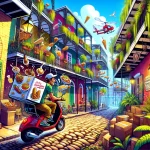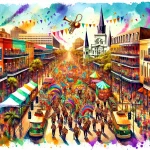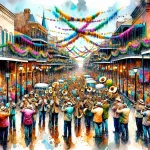Mardi Gras in the French Quarter is a vibrant celebration deeply rooted in the city’s rich cultural tapestry. As the epicenter of this world-renowned festival, the French Quarter comes alive with colorful parades, lively music, and a contagious spirit of revelry.
In This Article
TL;DR
- Mardi Gras in the French Quarter is a celebration intricately woven with the city’s heritage, blending French, Spanish, African, and Native American influences.
- Essential planning includes securing accommodations and transportation well in advance, respecting local traditions and etiquette, and embracing the spirit of revelry responsibly.
- Iconic parades like the Krewe of Zulu and Krewe of Rex, along with indulging in traditional fare like king cake, beignets, and gumbo, are must-experiences.
Historical Context of Mardi Gras in the French Quarter
The origins of Mardi Gras in New Orleans can be traced back to the city’s French colonial roots. In 1699, when French-Canadian explorer Jean Baptiste Le Moyne Sieur de Bienville established the city, he brought with him the traditions of the Carnival celebrations from his homeland. Over the years, Mardi Gras evolved into a unique and vibrant celebration, blending French, Spanish, African, and Native American influences. The first recorded Mardi Gras parade in New Orleans took place in 1837, organized by a group of students. Since then, the festival has grown into a world-renowned event, attracting millions of visitors annually.
Planning Your Visit
To fully immerse yourself in the Mardi Gras experience in the French Quarter, it’s essential to plan your visit carefully. The peak of the festivities typically occurs in the two weeks leading up to Fat Tuesday, with the most significant parades and events taking place during the final weekend.
When it comes to accommodations, the French Quarter offers a wide range of options, from historic hotels to charming bed and breakfasts. However, it’s advisable to book well in advance, as rooms tend to fill up quickly during this popular time of year.
Transportation can be a challenge during Mardi Gras, as the streets of the French Quarter become congested with revelers and parade routes. Consider staying within walking distance of the main attractions or utilizing public transportation or ride-sharing services to navigate the area more efficiently.
Safety and Etiquette
While Mardi Gras is a joyous occasion, it’s crucial to prioritize safety and follow proper etiquette to ensure an enjoyable experience for all. Crowds can be overwhelming, so it’s essential to stay vigilant and keep valuables secure.
Respect the local culture and traditions by adhering to the Mardi Gras etiquette. Avoid inappropriate behavior, and be mindful of your surroundings. Interacting with parade participants and other attendees is encouraged, but always do so in a respectful and friendly manner.
Must-See Events and Parades
No visit to the French Quarter during Mardi Gras would be complete without witnessing the iconic parades. The Krewe of Zulu and the Krewe of Rex are among the most renowned, featuring elaborate floats, marching bands, and costumed revelers tossing beads and trinkets to the crowds.
In addition to the parades, the French Quarter hosts a variety of special events, including lavish balls, costume contests, and live music performances. Securing a prime viewing spot along the parade routes or at these events can be challenging, so plan ahead and arrive early.
Food and Drink
Mardi Gras in the French Quarter is not just about the parades and parties; it’s also a celebration of the city’s rich culinary heritage. Traditional Mardi Gras foods, such as king cake, beignets, and gumbo, are must-tries during your visit.
The French Quarter is home to some of the city’s most renowned restaurants, offering a variety of Creole and Cajun cuisine. From iconic establishments like Brennan’s and Galatoire’s to hidden gems tucked away in the side streets, there’s no shortage of delectable dining options.
Don’t forget to indulge in the local beverages as well. From classic cocktails like the Sazerac and the Hurricane to the ever-popular local brews, the French Quarter offers a wealth of options to quench your thirst during the festivities.
Cultural Insights
Mardi Gras in the French Quarter is more than just a celebration; it’s an intricate tapestry of cultural traditions and symbolism. The vibrant masks and costumes worn by revelers are not merely for show but hold deep significance, representing the spirit of revelry and the shedding of societal constraints.
The krewes, or social organizations, play a crucial role in organizing and staging the parades and events. Each krewe has its own unique history, traditions, and symbols, adding to the diversity and richness of the Mardi Gras experience.
The colors of Mardi Gras – purple, green, and gold – represent justice, faith, and power, respectively, and are prominently displayed throughout the festivities.
Tips for First-Time Visitors
If you’re a first-time visitor to Mardi Gras in the French Quarter, there are a few essential tips to keep in mind:
- Dress comfortably and wear sturdy shoes, as you’ll be doing a lot of walking and standing.
- Arrive early to secure a prime viewing spot for parades and events.
- Stay hydrated and pace yourself, as the festivities can be physically and mentally demanding.
- Respect the local culture and traditions, and follow proper etiquette.
- Embrace the spirit of revelry and let loose, but do so responsibly.
Engaging with the Community
Mardi Gras in the French Quarter is not just a spectacle but a celebration deeply rooted in the local community. Visitors have the opportunity to engage with locals and participate in community events, gaining a deeper appreciation for the rich cultural heritage of New Orleans.
Consider volunteering during Mardi Gras, whether it’s assisting with parade preparations or participating in neighborhood clean-up efforts. This not only contributes to the success of the festivities but also allows you to interact with locals and gain valuable insights into their traditions and way of life.
Striking up conversations with locals and listening to their stories and perspectives can enrich your understanding of Mardi Gras and the French Quarter. They may share insider tips, recommend hidden gems, or provide a deeper appreciation for the cultural significance of the celebration.
By immersing yourself in the community and embracing the spirit of Mardi Gras, you’ll create lasting memories and forge a deeper connection with the vibrant culture of New Orleans.






